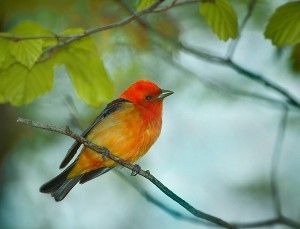“You’re getting up when?”
“You’re going out in this weather?”
People who have a passion for the outdoors and revel in the beauty and the subtle and not so subtle intricacies of nature are accustomed to these questions and their accompanying incredulous stares. The questions give me pause to wonder if the questioner has ever watched the sun, dripping red, crawl out of the blue ocean at dawn or ever seen the dappled light of the morning sun, like spotlights on the forest floor or ever sat with back against a solid oak and watched the last milky wisps of fog ascend from the mountain side after a sudden summer shower.
There are certainly grand and exotic places, beautiful and intriguing creatures and vistas to die for around the globe. But so often that “ah-ha” moment in nature comes simply, suddenly and without fanfare.
We were on the Blue Ridge Parkway last Saturday (May 1) for the Haywood County Arts Council’s annual “Birding for the Arts.” We had ambled away from our cars, peering into the gray but greening windy woods trying to put some corporeal shapes to the invisible warbles emanating from the forest. We turned to walk back to our cars and Joe Sam Queen called out, “I’ve got a scarlet tanager!”
We followed Joe Sam’s finger to a large maple at the edge of a clearing. At the end of a branch, surrounded by burgeoning maple leaves and waning flowers, framed by the overcast sky, was a most exquisite orange-variant scarlet tanager. Now scarlet tanagers are beautiful birds in their standard dress – deep scarlet front and back with jet-black wings and tail. But on this bird the scarlet was replaced with a soft, lush pumpkin-orange. And the soft light from the overcast sky let you drink in all the subtle shades and tones and drink in the intricate hues.
The next day, Sunday May 2, I was again on the Parkway in search of Neotropical migrants. I was with Chuck Dayton, Sara Evans and some friends of theirs from Minnesota and Asheville. The blustery wind was making it difficult to get good looks at birds when and if we could find them. We were hearing chestnut-sided warblers regularly but having no luck at coaxing them up for a gander. Then suddenly, at one overlook a fresh male popped up from the underbrush and flew into a small, mostly bare tree, not 20 feet from the edge of the overlook.
He seemed oblivious to the nine pairs of binoculars focused on him as he serenaded. He turned, first right profile and then left profile – showing us the rich chestnut sides he is named for as well as a bold black eye stripe and black chin streak. His yellow pincushion cap gleamed in the sunlight. He faced us, threw back his head and sang with gusto – “pleased, pleased, pleased to meetcha!” Next he turned his back to us and threw up his head. From his nape, down the middle of his back, he fairly glistened a yellowish green, interspersed with deep black lines.
And that, my friends, is why we do it.

